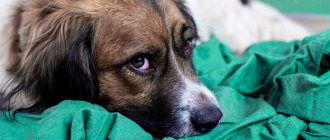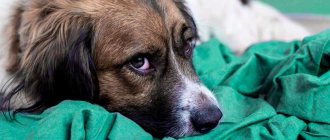A cold in a dog is a whole group of upper respiratory tract pathologies that develop when the animal is hypothermic for a long time. Being in the cold increases the body's susceptibility to pathogens, makes infection easier, and the dog gets sick. This is manifested by symptoms indicating damage to the epithelial tissue of the mucous membrane of the nose, pharynx, and larynx. It is here that the primary deposition and reproduction of the pathogen occurs. The infection, as it progresses, causes the development of inflammatory processes and disruption of the functioning of vital organs and systems. Pathogens may have a viral, bacterial or intracellular etiology. The main provoking factor of the disease is reduced immunity. From this article you will learn what causes a cold, what are the symptoms, methods of treating and preventing the disease in dogs, and whether it can be contracted from a person.
What it is?
Pathogens, affecting the mucous membrane of the respiratory tract, cause inflammation. Toxins, the products of their vital activity, enter the bloodstream and are distributed throughout the body. The severity of the disease depends on the activity of the virus and the state of the animal’s immune system. If the immune system is weakened, the virus reduces it even more, which is why a secondary bacterial infection occurs at the acute stage of the disease. In the future, other complications may appear.
There are quite a few types of ARVI pathogens that affect the dog’s body. The most common are rhinoviruses, influenza viruses, parainfluenza, coronaviruses, adenoviruses and others.
Depending on the involvement in the pathological process, the following are distinguished:
- ARI of the lower respiratory tract: bronchitis, tracheitis, laryngitis;
- Acute respiratory infections of the upper respiratory tract: sinusitis, tonsillitis, pharyngitis.
A dog's body is especially susceptible to infections if its defense system fails. But there are a number of other conditions of the body and external conditions under which the likelihood of getting sick increases many times:
- Overflow of blood vessels in the skin after physical activity or running (a hot dog can easily become hypothermic and catch a cold).
- Moisturized fur and skin are good conductors of cold (a dog caught in the rain or recently bathed loses the ability to normal thermoregulate and may get sick).
- Draft (moving air flow cools the skin and also causes a cold).
- Muscle fatigue after significant physical work weakens the dog’s body, causing them to catch colds and get sick.
Emergency help for hypothermia
If the owner notices the first warning signs, he should immediately provide assistance to his pet. Among the most effective actions are:
- Transfer the dog to a warm and dry room;
- Using warm water bottles that can be placed on the animal's limbs or body. The water temperature should not exceed 400C, so as not to cause skin burns;
- Wrap the animal in a warm blanket or jacket. This will allow him to quickly normalize his body temperature;
- Feed the dog. You should not offer him dry or solid food. The optimal solution would be warm milk or a good rich broth;
- Temperature level control. Measurements should be taken at least once every 30-40 minutes. This will allow you to monitor your pet’s condition over time and assess the level of threat to life.
Veterinarians remind that there are several erroneous actions that inexperienced owners take:
- Rubbing the dog's paws with your hands or a hard cloth. Mechanical impact increases tissue swelling and causes unnecessary pain to the animal;
- Using hot water for warming;
- Trying to get the dog to move in order to speed up the blood flow and return it to normal as quickly as possible.
Such actions only aggravate the pathological process and can cause complications. A consultation with a veterinarian will help you choose the best course of care for your dog.
Provoking factors
Let's list the main triggers for colds:
- Heredity. Representatives of decorative artificially bred breeds are most prone to colds, since their genetic feature is weak immunity.
- Elderly dogs. Degenerative age-related changes in the body also affect the immune system. Such individuals are more likely to have colds and pathologies of other organs.
- Small breed dogs. They normally have a higher body temperature than their larger counterparts, so they are more susceptible to chilling.
- Aviary maintenance. When keeping a large number of dogs together, the virus spreads between them very quickly, and preventing this process takes a lot of work.
- Violation of the rules of care and maintenance. This is a very important factor. This includes: poor quality diet, poor in vitamins and microelements; keeping outside in cold weather; untimely deworming; violation of the vaccination calendar; lack of annual preventive veterinary examinations.
The situation is especially dangerous if the dog has come into contact with ice water, accidentally falling into a pond or falling through the ice. In addition to external cooling, cold water is swallowed and inhaled. A cold can affect the lungs, turning into severe pneumonia. In such cases, it is necessary to immediately warm the animal so that its body can successfully cope with hypothermia. It is advisable to contact your veterinarian to prescribe a course of preventive therapy.
Possible complications
If you do not seek veterinary help in time (or do not diagnose the disease correctly), the inflammation will continue to develop and begin to affect nearby areas of the body. In this case, it will be almost impossible to stop the inflammatory process without consequences. Complications that are possible with myositis in dogs include:
- weakening of one or several muscles at once, up to complete death (in which case they cease to perform their functions);
- further spread of the infectious disease and the occurrence of abscesses (purulent lesions);
- change in size of one or more damaged muscles - they become deformed and become noticeably shorter;
- Deterioration of vision in an animal is one of the common consequences of eosinophilic myositis.
Is the disease transmitted from humans?
Many people are interested in whether a dog can catch a cold from a person? Viruses that infect dogs and humans are of different strains, so in most cases, dogs cannot become infected from people.
But, the results of recent studies have shown that some types of viruses have mutated, having learned to adapt to life in an unfamiliar environment. Such viruses include, for example, the H1N1 swine flu virus. Recently, several cases of dog infection from a person suffering from this type of influenza have been reported. In this case, the symptoms of the disease are similar, and the same treatment regimens are used. It is possible that there are some other types of pathogens that can adapt to existence in the body of both dogs and humans.
Can a dog get infected?
If you notice symptoms that your dog has a cold, check with your veterinarian about what to do. Taking human cold medications is not allowed, as people and animals become infected from different strains of the virus. You will never infect your pet with a viral infection, and he will never infect you.
The opposite situation is typical for bacterial and fungal diseases. But here, too, the source of infection is not the person himself, but the causative agents of the disease. Infected animals are also dangerous to other four-legged pets. Timely isolation of the infected person and thorough wet cleaning of the entire room will help prevent the development of infection.
Symptoms of the disease
Colds have numerous symptoms in dogs. The incubation period lasts about 2 days. Then an acute period begins, during which the signs of a cold appear especially clearly, because the dogs suffer from intoxication:
- lethargy, refusal to play, desire to sleep;
- refusal to eat;
- increased body temperature;
- runny nose - clear discharge from the nose;
- photophobia - the dog strives to be in the dark;
- dull, matted fur;
- enlarged lymph nodes.
Sneezing and a dry cough indicate that the dog has a severe cold and the infection is progressing, affecting the lower respiratory tract.
If the dog exhibits typical symptoms (provided it has good immunity), by day 3 it already feels better. Full recovery occurs in approximately 7-10 days. The contagious period can begin a day or two before symptoms appear and last until they disappear completely.
Application of drops: result
If the infection contributes to the development of rhinitis, special drops are prescribed. Before using them, the pet’s nasal sinuses are washed with saline so that the active substance penetrates the site of inflammation faster and easier.
Such drugs as Anandin, Maxidin, Pinosol work well. They are instilled into the dog’s nose according to the doctor’s instructions and instructions, which specify the frequency and duration of treatment, as well as the safe dosage.
If the disease has become chronic, use Thymogen drops. They are combined with other drugs in situations where an animal’s runny nose goes away with elevated body temperature and other complications.
Diagnosis of the disease
To understand how to treat a dog, the doctor collects anamnesis, questioning the owner about its condition and behavior. Then he conducts an external examination, auscultation of breathing and the functioning of the cardiovascular system. Gives directions for general blood and urine tests.
It is important to differentiate a cold from a more serious condition with severe consequences - canine distemper in its pneumonic form. Its peculiarities are purulent nasal discharge, wheezing in the chest and a hysterical cough. Therefore, if a mild form of a cold can be treated at home without resorting to the help of a veterinarian, then if the symptoms become more severe, measures should be taken. In this case, the dog must be brought for a diagnostic examination to a veterinary clinic.
Tips for the owner
Self-medication has never brought the desired result, especially when colds occur in dogs. Symptoms may be identified incorrectly and may only make things worse for the animal. When your pet is sick and you can call a veterinarian to your home, you need to use this service. Upon arrival, the doctor will examine the animal, and if he advises hospitalizing it, it is better not to refuse, since colds in dogs can be very insidious. Complete treatment can be obtained in the clinic under the supervision of specialists.
Treatment of the disease
A dog with a mild cold is treated at home. Sometimes you can get by with restorative methods. Stimulating the immune system will improve the condition and allow your pet to be cured quickly. The main therapeutic measures for colds are:
- It is important to provide the dog with peace.
- It is necessary to create a therapeutic diet with a high protein content.
- Additionally, it is recommended to take vitamin complexes. Particular attention should be paid to the immunostimulating vitamin C.
- Be sure to ensure that your pet has access to fresh water.
- It is recommended to reduce the number of walks and eliminate physical activity.
- It is helpful to clean the nostrils and eyes with a damp cloth.
- Particular attention should be paid to ensuring that the dog is warm at all times. Warm bedding is needed, and the possibility of drafts should be excluded.
- You can brush your dog while simultaneously making massage movements and stimulating blood circulation.
Drug treatment is prescribed by an experienced veterinarian. Typically, the following drugs are used to treat colds:
- antiviral agents: Cycloferon, Viferon;
- antihistamines: Diphenhydramine, Suprastin;
- immunomodulatory agents: Gamavit, Interferon.
If a secondary bacterial infection occurs, antibiotics (Amoxiclav, Dorin) and, at the same time, drugs to restore intestinal microflora (Enterol) are prescribed. Licorice root is very helpful for dog coughs.
Everyone is talking about coronavirus infection. Maybe it's her?
Like any other concerned pet owner, as you read and listen about the coronavirus, you've probably thought about the risk of it spreading from you to your pet and vice versa. There is currently no evidence that dogs, cats. As the situation with coronavirus infection COVID-19 continues to evolve, it is important to monitor updates and follow the recommendations of the World Health Organization (WHO), the Federal Service for Surveillance on Consumer Rights Protection (Rospotrebnadzor) and other international and national health organizations.
To date, there is no evidence that dogs, cats or other pets can get COVID-19. The World Small Animal Veterinary Association (WSAVA) has published on its official website a very useful, regularly updated document, available in Russian, that will help you understand the situation and provide answers to specific questions.
Preventive actions
The main means of saving from frequent colds are measures to strengthen the immune system and prevent hypothermia:
- In the cold season, you should put a blanket or warming overalls on your dog. It is not recommended to walk for a long time with a small dog. You need to make sure that your pet moves more during walks.
- Service dogs cannot be kept outside during frosts; they must be moved to a warm room.
- To avoid the spread of infection, a cold dog should not be allowed to interact with healthy fellow dogs.
- If the symptoms of a cold progress and complications appear, you should not delay visiting the veterinarian.
- Despite the fact that dogs become infected with people very rarely, a dog should not be allowed to interact with a person sick with the flu. During epidemics, you should take her out into fresh air more often.
- We must not forget about timely vaccination of the dog.
If your dog has a cold, you need to take all measures to prevent complications, which are difficult to treat and have unpredictable consequences.
The most common complication of a cold is inflammation of the outer and inner ear (otitis). The inflammatory process can reach the lower respiratory tract and bronchitis or pneumonia will develop. Lymph nodes can also be targeted.
At first glance, it may seem that a cold does not pose any particular danger to a dog, but this is not so. Like any disease, it can have serious complications. Therefore, it is important to begin treatment without wasting time, and, if necessary, take your pet to a veterinary clinic where he will receive professional assistance.
Cold prevention
In all its forms, in dogs is the following:
- Timely vaccinations to exclude viral infections and be calm about the health and life of your dog.
- Periodic treatments against endo- and ectoparasites (from internal - helminths, and external - fleas and ticks).
- Complete feeding
- If the dog lives in the house, its place should not be in a draft and there should be warm bedding so that the pet does not sleep on the cold floor. If the dog lives on the street or in an enclosure, it is necessary to provide him with a dry, insulated booth. It is necessary to walk kennel dogs to ensure an active lifestyle.
- Under no circumstances should the animal be given cold water or frozen food.
- Avoid long walks in cold, windy weather.











